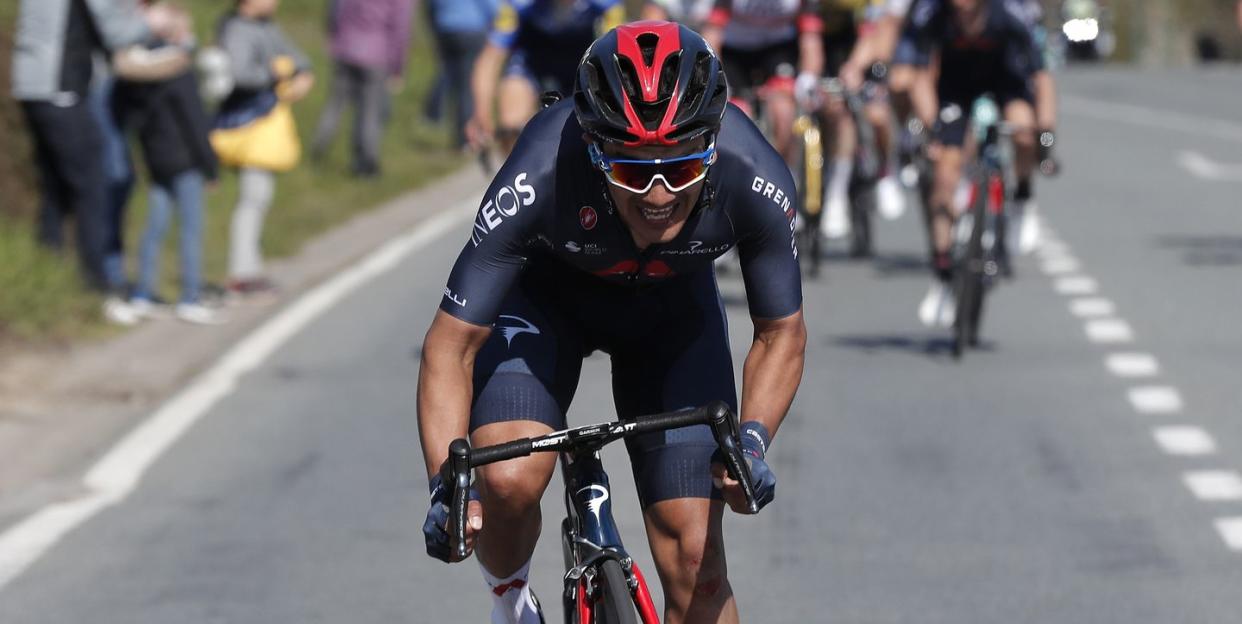The UCI Is Risking a Major PR Debacle With Its Strict Punishments for the Supertuck

- Oops!Something went wrong.Please try again later.
Richard Carapaz was off the front at Liege-Bastogne-Liege when he made a terrible mistake. He didn’t crash, but the end result, at least as far as the standings go, was the same.
With just 19km to go in the 259km Monument, Carapaz—a former Giro d’Italia winner who rides for Team INEOS Grenadiers—had 20 seconds on the chase when he briefly leaned forward off the saddle during a descent. The move, where a rider crouches low on the bike frame instead of the seat for better aerodynamics, is called a supertuck, and it’s one of several positions newly banned in bike racing by the UCI. The penalty is harsh: disqualification.
→ Sign up for Bicycling All Access for the latest cycling news, health advice, and product reviews 🚲
Carapaz is the third rider to be disqualified for a banned position since the rules took effect on April 1, and he’s easily the highest-profile cyclist to be punished. And because his attack was unsuccessful—he rolled across the line in 29th position, 1:21 down to eventual winner Tadej Pogačar—cycling escaped a major controversy.
But had Carapaz won, the UCI could have been forced to DQ a winner, which would create quite the debacle. Thankfully, the UCI can avoid that with one simple response.
The general theme of the UCI’s new restrictions is pretty basic: Keep your butt on the seat and your hands on the handlebars. The stated rationale is safety, despite the fact that evidence of crashes resulting from various banned positions is vanishingly thin. The UCI also banned riders from tossing trash, such as empty water bottles, outside of certain disposal zones, in the name of environmental image (which is a questionable reason in itself). The punishment for both offenses was a DQ.
Both tossing water bottles and the now-banned riding positions have been common practice for years, so the fact that the UCI signaled the rule changes in December, but didn’t announce them until February, after racing had already started, created issues for cyclists. Even worse: the UCI oddly chose a mid-season date to start enforcing these rules, making riders flip a mental switch on longstanding behaviors at a weird time. At Dwars door Vlaanderen (March 31), supertucking or flicking a roadside fan a souvenir bottle were perfectly legal; four days later, at the Tour of Flanders, they weren’t.
That, combined with the draconian penalty, is clearly causing problems. Riders have generally adapted quickly, but Michael Schar was disqualified for a bottle toss at Flanders. Two riders—Gijs Leemreize from Brabantse Pijl and Alexander Richardson at the Tour of Turkey—were recently DQ’ed for banned positions.
The UCI itself doesn’t DQ a rider; race juries do. The members are drawn from a pool of more than 300 licensed International Road Commissaires, and they’re subjective, fallible. And for banned positions, the UCI has given them only one very blunt tool.
Yes, riders are responsible for knowing and following the rules. But Carapaz’s crime, at least, was victimless: he was alone (no safety issue) and tucked for at most a few seconds before he seemed to catch himself, popping back up to a normal position. Is disqualification—usually reserved for flagrant shenanigans like cutting off another rider in a sprint—really an appropriate punishment for a momentary mental lapse, after six hours of racing, on a rule that changed just four weeks prior?
After the outcry over the Schar DQ, the UCI softened the penalties on littering: riders are now DQ’d only on the third instance. But the harsh response for banned positions remains.
The Carapaz DQ sets a terrible precedent where any offense, no matter how small, must be disqualified. What happens if a rider supertucks, wins, and then is DQ’d after the race? Or an especially famous rider supertucks and isn’t DQ’d, raising fair criticism of double standards?
📬 Get all of the cycling news you need—and more!—in our newsletter.
There’s one easy way out of this: lighten the punishments. At least give riders a transition year where the penalty for a first offense in a race is far less harsh: fines, or a time penalty.
So far, the UCI hasn’t budged. But that sets up a scenario, say, late in May’s Giro d’Italia, where a top GC rider is thrown out of the race while on a daring raid in the Dolomites in pursuit of the pink jersey. The Italians love a good polemica, and the UCI is, if you’ll pardon the pun, well positioned to deliver one.
You Might Also Like

